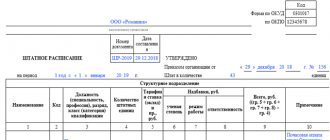Length of working hours in local regulations
When employing an employee in a company, it is obligatory for him to perform job duties during the working period.
The shift, specifically the start and end time of the work day, and the lunch break are negotiated with the management before signing the contract. Most often, employees are hired full-time. The basic concepts of the working day are reflected in Art. 91 Labor Code of the Russian Federation. It describes the interpretation of the term and indicates the normally possible duration of the labor function during the day.
Average working hours
Indicators of employee time use are based on labor balance information. The following indicators exist.
The utilization rate of the maximum possible working period fund is calculated as follows:
K m.v.f.=(Tf/T m.v.f.)*100
TF – time worked as usual
T m.v.f. – maximum allowable working time.
The coefficient shows how working time is used in companies and their branches.
Time fund utilization rate:
Kt.f.=(Tf/Tt.f)*100
Tt.f. – time fund.
The indicator helps to compare the use of labor time in the face of inter-industry differences.
Labor segment utilization rate in days:
Kisp.work = average duration of labor in days/number of working days in the specified interval
Full time in the Labor Code of the Russian Federation
What does the concept of “full time” mean? In Art. 92 of the Labor Code of the Russian Federation states that the length of the working week is forty hours. Mathematically, you can calculate the number of working hours per day. To do this, divide 40 by 5 to get 8 hours. Certainly, this amount of time is worked by people who carry out their work functions at full time and on a five-day schedule.
The company can specify a certain number of hours and, if desired, what your work schedule will be. For example, your employee handbook may indicate 9:00 am to 6:00 pm or simply state 45 hours per week.
What is full rate
The term "full time" is inseparable from the concept of "working time". This is one of the aspects of labor relations regulation. To create work and rest time regimes that are comfortable for the health of employees, some restrictions are provided in relation to the maximum duration of the working day.
The rate indicates the cost of an employee’s labor function for a full day, that is, 8 hours.
Full time means an employee works under the maximum established shift duration. Rate plays a big role in many aspects of labor law. For example, the minimum wage applies specifically to full-time employees.
Full Time How Many Hours a Day?
Official employer designations for full-time employees typically range from 35 to 45 hours, with 40 hours being the most common standard. I've heard of some companies considering 50 hours a week full time for exempt employees.
- Full day work schedule is like
- Full rate is how many hours
- How much is a full day of work?
If your status changes, you should also be informed by your manager or Human Resources.
Affordable Care Act Definition of Full Time Employment (read more...)
Length of working day for all women
A 40-hour work week is legally established for everyone. How many hours a day should an ordinary woman work? According to Article 100 of the Labor Code, the work shift regime takes into account the standard length of the work week. Typically, employers divide the number of hours by the number of working days. There are 5, 6-day weeks, as well as work schedules with shift or sliding hours. Planned breaks and the start time of the working day are taken into account. For example, with a 5-day week, the length of the day will be 8 hours with one hour break for eating or resting.
Full-time or part-time classes
With the introduction of the Affordability Act (Obamacare), the definition of a full-time employee was established as an employee who spends an average of 30 hours or more per week at work.
The standard for full-time employment has generally been 40 hours per week in the past. However, many employers now view employees as full-time employees working fewer hours. i.e. more than 30 hours, 35 hours or 37 hours 5 hours. Because there are no laws governing full-time employment for compensation and benefits purposes, the organization determines how many hours per week are considered full-time employment.
How to calculate if the employee is a minor
It would seem that there is no difference: for teenagers, restrictions are set by hours, not by days. But we need to clarify: how many hours does a full working day mean? Children under 16 have the right to work, in accordance with Article 92 of the Labor Code of the Russian Federation, no more than 24 hours per week. But how will they be distributed? Various options are possible:
- 3 days for 8 hours;
- 4 days for 6 hours;
- 6 days for 4 hours.
The compilers of the production calendar were guided by a five-day week of 8 hours each and calculated the average monthly number of working days in 2021 with a 40-hour week.
In our case, if we take an eight-hour work day as a basis, the number of days is 3/5 of the usual “adult” norm. Therefore, we multiply the number of days in a month by 3/5.
So, for example, in September a 15-year-old worker has not 20 days worked, but 12.
It turns out that for the calculation we do not need to divide the working day into parts, but a kind of “adjustment” to the eight-hour period.
Full Time How Many Hours a Day?
On the eve of the weekend, the duration of work in a six-day work week cannot exceed five hours.
The duration of work at night is equal to the duration of work during the day in cases where this is necessary due to working conditions, as well as for shift work with a six-day work week with one day off. The list of specified works may be determined by a collective agreement or local regulations.
Article 91. Concept of working time. Normal working hours (read more...)
Legal regulation of full-time work
To better understand how full-time wages are regulated by law, employees and employers should familiarize themselves with the regulations governing this issue. Knowledge of the law will allow you to avoid any violations of the rights of the parties to the employment contract. Thus, the concept of full rate and its practical application is influenced primarily by the following standards of the Labor Code of the Russian Federation:
- Article 2 regulates the regulation of working hours within the framework of labor legislation, as a way to ensure fair working conditions that would provide for the possibility of rest for workers.
- Article 21 provides for the mandatory right of employees to receive a certain amount of rest, in amounts no less than those provided for by labor legislation.
- Article 57 considers the content of employment contracts and the need to indicate in them the work and rest regime only if they differ from those generally accepted by the employer. Therefore, the full rate is usually not mentioned in employment contracts - it is considered the default mode of the relationship.
- Article 91 establishes the very concept of working time and the principles for regulating its normal duration - it is in this case that the employee has the right to receive payment in the form of a full rate.
Legal regulation of the remuneration of teachers and medical workers may provide for the possibility of their employment at one and a half or two rates with individual features and nuances. Also, at one and a half or two rates, it may be possible to work in the internal part-time mode at one enterprise.
Article 95. Duration of work on the eve of non-working holidays and weekends
3) when performing work the need for which is due to the introduction of a state of emergency or martial law, as well as urgent work in emergency circumstances, that is, in the event of a disaster or threat of disaster (fires, floods, famine, earthquakes, epidemics or epizootics) and in other cases, threatening the life or normal living conditions of the entire population or part of it.
- Full day work schedule is like
- Full rate is how many hours
- How much is a full day of work?
A collective agreement may provide for an increase in the duration of daily work (shift) compared to the duration of daily work (shift) established by part two of this article for employees engaged in work with harmful and (or) dangerous working conditions, subject to the maximum weekly working hours time (part one of Article 92 of this Code) and hygienic standards for working conditions established by federal laws and other regulatory legal acts of the Russian Federation.
Irregular schedule: who is allowed and who is not allowed
An irregular schedule is not compatible with positions of employees who have a limited working day. In such cases, “involvements” are unacceptable by definition - since they actually lengthen the working day, which by law will not be extended.
The list of employees with a limit on the length of the working day is listed in Art. 94 of the Labor Code of the Russian Federation: in relation to them, an irregular schedule cannot be established at all.
You should also take into account the provisions of Art. 92 of the Labor Code of the Russian Federation, where for some positions a reduced number of working hours per week is established. If it is full, then none of the days will last the required 8 hours - accordingly, an irregular schedule is not applicable here due to the part-time working day.
It is possible to conclude a “non-standardized” employment contract only for a position that is included in the list of “non-standardized” ones by a collective agreement or local regulations of the enterprise (most often, the manager’s order is applied).
The main rule when compiling a list of such positions is to remember why the schedule, in fact, is called irregular. And that’s what it’s called, as the labor inspectorate writes, if a labor function is not subject to regulation. And if it is, then the employer should use overtime work instead of “unstandardized work.”
To understand which positions are characterized by “irregular” labor functions, the employer can look at (and even apply by analogy) Resolution of the Government of Russia No. 884 dated December 11, 2002. It establishes the rules for vacations with an irregular schedule in federal government institutions and determines, in particular, that “non-standardization” is a characteristic:
- managerial, technical, business personnel and other persons whose work cannot be accurately accounted for;
- persons who distribute working time at their own discretion;
- persons with working hours that are divided into periods of indefinite duration.
Another standard that is useful (and applicable by analogy) when compiling a list of “non-standardized” positions is Order No. 146 of the Federal Social Insurance Fund of Russia dated June 22, 2009. According to it, such positions include almost all management positions, supervisors, accountants, consultants, and specialists of the Fund. And also a chef, a garage manager, a driver. Depending on the specific position, an “irregular” employee of the Social Insurance Fund may be provided with up to 14 days of additional leave - significantly higher than the minimum according to the Labor Code of the Russian Federation.
It is important to include in the list only those positions in which (Letter No. 14-2/OOG-8616):
- employees perform labor functions primarily during normal working hours;
- “attractions” will be exceptions to the rule.
An employee can only be “engaged” based on his job function, which is enshrined in the employment contract. If the function is different, then his contract for overtime work will have to be redone.
Now let’s talk about how to document the results of accounting for “attractions”.









